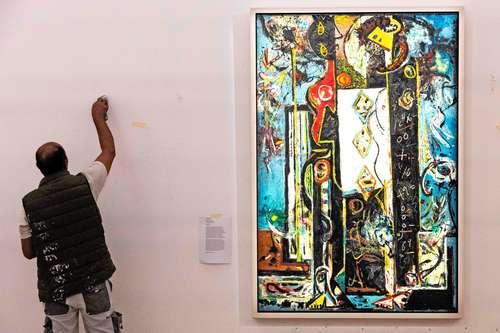Jackson Pollock under the influence of Picasso and Mexican muralism, in a Parisian exhibition
Paris. The decisive influence of Pablo Picasso and the Mexican muralists on the early career of the American painter Jackson Pollock, one of the great figures of abstract expressionist art, is the subject of an exhibition that opens this week in Paris.
Jackson Pollock (1912-1956) is considered one of the architects of the hegemony of American art after the Second World War. His technique drip
on large canvases, which he worked on the floor of his workshop, caused a sensation after their appearance in public around 1947.
That period lasted a few years, but it marked contemporary art and helped move the center of attention from Paris to New York, where Pollock had arrived as a student in 1930.
But the Pollock legend was born from a certain misunderstanding, says Joanne Snrech, curator of Jackson Pollock: The Early Years (1934-1947).
The exhibition, with nearly a hundred works, will be open at the Picasso Museum in Paris between this Monday and January 19.
There is a certain tendency to portray Pollock as a self-made man, emerging from a very humble family.
explains Snrech.
This theory assumes that the dripping or dripping of paint on fabrics was something totally personal, a desire to break with painting as an ancestral technique in which the brush necessarily caresses (or hits) the fabric so that the work of art emerges.
But Pollock arrived at this method after receiving varied influences in the bubbling New York of the 1930s, where all the great European masters who escaped totalitarianism were arriving, and also from Mexican muralists, such as Diego Rivera or David Alfaro Siqueiros.
The impact of Guernica
Pollock never met Picasso, but his work shook him ever since one of his brothers sent him a first brochure with photographs.
The great Picasso retrospective at the Museum of Modern Art in New York (MoMA) in 1939 dazzled him.
“It is the moment in which the Guernica disembarks in the United States, and we know that Pollock comes to see him several times,” explains the commissioner.
Numerous sketches and paintings emerge from that period, such as Birth (1941), in which the viewer witnesses the transfiguration of the famous Picasso horses or bulls, with enormous open jaws. Or the spectacular Mural, from 1943, composed with thick strokes.
Pollock imitates Picasso’s formative experience when he was young in Paris and is inspired by primitive art, in his case the indigenous artists of the West, whom he discovered in another historic exhibition at the MoMa in 1941.
Pollock reproduces indigenous totems, even trying sculpture, with a work carved in 1941 on an animal bone, rarely exhibited in public.
Siqueiros’ workshop
In turn, the United States fetes the muralists of its southern neighbor. Rivera or Siqueiros paint murals for American millionaires, museums and universities.
Siqueiros opens an experimental painting workshop in New York, which Pollock enrolls in. The workshop does not last long, and in the Paris exhibition you can read a letter of apology from the Mexican teacher to his students.
Pollock learns and absorbs all these influences, and while Europe is torn apart by war, he delves into his painting, which is also a cure for his growing problems with alcohol or depression.
Painting is a discovery of oneself. Every good artist paints what is
he explained in 1956.
His work became increasingly abstract, until the leap of 1947.
Years later, Picasso would express his skepticism about this revolutionary way of painting, reveals Joanne Snrech.
To Picasso, this lack of control of the gesture seemed like a waste of time; it was contrary to the spirit of the painting as he perceived it.
he points out.
